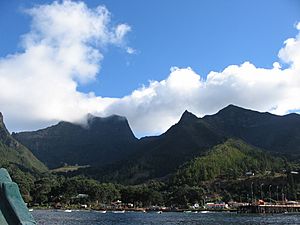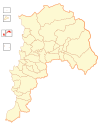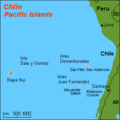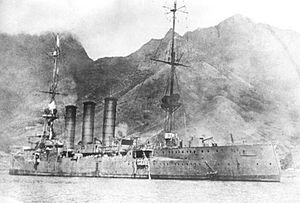Juan Fernández Islands facts for kids
Quick facts for kids
Juan Fernández Islands
Archipiélago Juan Fernández
|
||||||
|---|---|---|---|---|---|---|
|
Special Territory and Commune
|
||||||

The town of San Juan Bautista, Robinson Crusoe Island
|
||||||
|
||||||
| Country | ||||||
| Region | ||||||
| Province | Valparaíso | |||||
| Discovered | 22 November 1574 | |||||
| Colony status | 1895 | |||||
| Commune created | 21 September 1979 | |||||
| Special territory status | 30 July 2007 | |||||
| Named for | Juan Fernández | |||||
| Capital | San Juan Bautista | |||||
| Government | ||||||
| • Type | Municipality | |||||
| • Body | Municipal council | |||||
| Area | ||||||
| • Total | 99.6 km2 (38.5 sq mi) | |||||
| Elevation | 1,268 m (4,160 ft) | |||||
| Population
(2012 Census)
|
||||||
| • Total | 900 | |||||
| • Density | 9.0/km2 (23.4/sq mi) | |||||
| • Urban | 800 | |||||
| • Rural | 100 | |||||
| Sex | ||||||
| • Men | 536 | |||||
| • Women | 364 | |||||
| Time zone | UTC-4 (CLT) | |||||
| • Summer (DST) | UTC-3 (CLST) | |||||
| Area code(s) | 56 | |||||
| Currency | Peso (CLP) | |||||
| Website | Juan Fernández Islands | |||||
The Juan Fernández Islands (Spanish: Archipiélago Juan Fernández) are a small group of islands in the South Pacific Ocean. They are about 670 kilometers (416 miles) off the coast of Chile. These islands are known for their beautiful nature and unique wildlife.
The group has three main volcanic islands: Robinson Crusoe Island, Alejandro Selkirk Island, and Santa Clara Island. Most people live on Robinson Crusoe Island. The main town is San Juan Bautista.
The islands are famous because a sailor named Alexander Selkirk was left alone there for over four years. His story might have inspired the famous book Robinson Crusoe by Daniel Defoe.
The Juan Fernández Islands are part of Chile's Valparaíso Region. They are named after Juan Fernández, the Spanish explorer who found them in the 1570s.
Exploring the Juan Fernández Islands
Where are the Islands?
The Juan Fernández Islands are far out in the Pacific Ocean. They are made up of three main islands:
- Robinson Crusoe Island (also called Isla Más a Tierra) is closest to South America. It has smaller islands around it.
- Santa Clara is about 1 kilometer (0.6 miles) southwest of Robinson Crusoe.
- Alejandro Selkirk Island (also called Isla Más Afuera) is about 180 kilometers (112 miles) further west.
Island Sizes and Heights
Alejandro Selkirk is the biggest island, covering about 49.5 square kilometers (19.1 square miles). Its highest point, Cerro de Los Inocentes, is 1,268 meters (4,160 feet) tall. In 2012, about 57 people lived there.
Robinson Crusoe is the second largest island, about 47.9 square kilometers (18.5 square miles). Its highest peak, El Yunque, is 915 meters (3,002 feet) high. In 2012, about 843 people lived on Robinson Crusoe Island. Santa Clara is much smaller, about 2.2 square kilometers (0.85 square miles), and no one lives there.
The tall mountains on these islands can create a special cloud pattern called a Kármán vortex street. You can even see this pattern from space!
How the Islands Formed
The islands were formed by volcanoes. They appeared as the Nazca Plate (a huge piece of Earth's crust) moved over a "hotspot" deep underground. Over millions of years, this movement created a chain of underwater mountains, and the highest parts became the islands we see today.
Scientists believe Santa Clara is the oldest island, about 5.8 million years old. Robinson Crusoe is 3.8 to 4.2 million years old, and Alejandro Selkirk is the youngest, at 1.0 to 2.4 million years old.
Climate and Weather
The islands have a mild, subtropical climate. This means it's usually warm but not too hot. The weather is kept cool by the Humboldt Current, a cold ocean current, and by steady winds.
Temperatures usually stay between 10°C (50°F) and 25°C (77°F). The average temperature is about 15.7°C (60.3°F). Higher places on Robinson Crusoe Island can sometimes get light frosts.
The islands get a lot of rain, about 1,092.8 millimeters (43 inches) each year. The amount of rain can change a lot depending on the El Niño weather pattern. It rains more in the winter months. Higher areas often get rain almost every day.
| Climate data for Archipiélago Juan Fernández (1981-2010, extremas 1958-presente) | |||||||||||||
|---|---|---|---|---|---|---|---|---|---|---|---|---|---|
| Month | Jan | Feb | Mar | Apr | May | Jun | Jul | Aug | Sep | Oct | Nov | Dec | Year |
| Record high °C (°F) | 28.8 (83.8) |
27.8 (82.0) |
27.0 (80.6) |
26.0 (78.8) |
24.8 (76.6) |
22.2 (72.0) |
22.6 (72.7) |
24.4 (75.9) |
21.8 (71.2) |
23.5 (74.3) |
25.2 (77.4) |
26.9 (80.4) |
28.8 (83.8) |
| Mean daily maximum °C (°F) | 25.2 (77.4) |
23.1 (73.6) |
21.1 (70.0) |
19.3 (66.7) |
17.6 (63.7) |
16.2 (61.2) |
15.0 (59.0) |
14.8 (58.6) |
15.0 (59.0) |
16.0 (60.8) |
17.6 (63.7) |
20.8 (69.4) |
18.5 (65.3) |
| Daily mean °C (°F) | 22.1 (71.8) |
19.8 (67.6) |
18.1 (64.6) |
16.5 (61.7) |
15.0 (59.0) |
13.6 (56.5) |
12.5 (54.5) |
12.2 (54.0) |
12.3 (54.1) |
13.3 (55.9) |
14.8 (58.6) |
18.2 (64.8) |
15.7 (60.3) |
| Mean daily minimum °C (°F) | 19.1 (66.4) |
16.6 (61.9) |
16.1 (61.0) |
14.6 (58.3) |
13.1 (55.6) |
11.8 (53.2) |
10.8 (51.4) |
10.4 (50.7) |
10.4 (50.7) |
11.3 (52.3) |
12.7 (54.9) |
15.7 (60.3) |
13.6 (56.5) |
| Record low °C (°F) | 10.6 (51.1) |
9.3 (48.7) |
7.1 (44.8) |
4.2 (39.6) |
4.6 (40.3) |
4.8 (40.6) |
5.0 (41.0) |
3.0 (37.4) |
5.0 (41.0) |
6.2 (43.2) |
7.3 (45.1) |
9.2 (48.6) |
3.0 (37.4) |
| Average precipitation mm (inches) | 42.5 (1.67) |
44.5 (1.75) |
60.3 (2.37) |
91.1 (3.59) |
160.8 (6.33) |
180.1 (7.09) |
160.2 (6.31) |
126.3 (4.97) |
87.7 (3.45) |
54.1 (2.13) |
45.1 (1.78) |
40.1 (1.58) |
1,092.8 (43.02) |
| Average precipitation days (≥ 0.1 mm) | 11 | 10 | 13 | 15 | 21 | 23 | 21 | 19 | 16 | 14 | 10 | 10 | 183 |
| Average relative humidity (%) | 73 | 73 | 73 | 77 | 78 | 78 | 79 | 77 | 77 | 76 | 74 | 73 | 76 |
| Mean monthly sunshine hours | 248.0 | 209.1 | 158.1 | 123.0 | 108.5 | 99.0 | 93.0 | 105.4 | 147.0 | 204.6 | 249.0 | 260.4 | 2,005.1 |
| Source: Dirección Meteorológica de Chile | |||||||||||||
Plants and Animals: Unique Life on the Islands
The Juan Fernández Islands are special because they have many plants and animals found nowhere else in the world. These are called endemic species. Because the islands are far from other land, the plants and animals had to travel long distances to get there.
Amazing Plants
There are 209 types of native plants on the islands. About 126 of these (62%) are endemic, meaning they grow only here. Many plants are similar to those found in southern South America, New Zealand, and Australia.
Different types of plants grow at different heights on the islands.
- Lower areas have grasslands and shrubs.
- Middle areas have tall forests.
- Higher areas have more shrubs and grasslands.
Two main tree species are found on both islands: Drimys confertifolia and Myrceugenia fernandeziana (on Robinson Crusoe) or M. schulzei (on Alexander Selkirk). There are also special tree ferns, like Dicksonia and Thyrsopteris.
Sadly, an endemic sandalwood tree, Santalum fernandezianum, was cut down too much for its wood. It hasn't been seen since 1908 and is now believed to be extinct. The Chonta palm (Juania australis), another endemic plant, is also in danger.
- Maps and satellite images of the islands
Wonderful Animals
The Juan Fernández Islands have very few native land animals like mammals, reptiles, or amphibians. But they are home to many unique birds and sea creatures!
Humans have brought some animals to the islands, like rats and goats. These animals can sometimes harm the native wildlife.
Birds of the Islands
Seventeen types of land and sea birds live and breed on the islands. Three bird species and three bird subspecies are endemic to these islands.
- The Juan Fernández firecrown (Sephanoides fernandensis) is a beautiful, endangered hummingbird found only on Robinson Crusoe Island. There are only about 500 of them left.
- The Juan Fernández tit-tyrant (Anairetes fernandezianus) also lives on Robinson Crusoe Island.
- The Masafuera rayadito (Aphrastura masafuerae) is found only on Alejandro Selkirk Island.
Two types of petrels, the Stejneger's Petrel and the Juan Fernandez Petrel, lay all their eggs on these islands. Another petrel, De Filippi's Petrel, might also breed here. All three islands are recognized as Important Bird Areas (IBAs) because they are so important for birds. The Magellanic penguin also breeds on Robinson Crusoe Island.
Sea Animals
The waters around the islands are home to the endemic Juan-Fernandez spiny lobster (Jasus frontalis). This lobster does not have claws.
The Juan Fernández fur seal (Arctophoca philippii) also lives on the islands. This species was almost wiped out by hunting between the 16th and 19th centuries. Luckily, it was rediscovered in 1965. In 1970, about 750 fur seals were counted. Their population seems to be growing by 16-17% each year!
History of the Islands
Early History and Discovery
Scientists believe that no humans lived on the Juan Fernández Islands before Europeans arrived.
The islands were discovered on November 22, 1574, by a Spanish sailor named Juan Fernández. He was sailing a new route that avoided strong ocean currents. He named the islands Más Afuera, Más a Tierra, and Santa Clara.
Pirates, Sailors, and Penal Colonies
In the 17th and 18th centuries, the islands were a secret hideout for pirates. They also became a place where prisoners were sent, known as a penal colony. This is when Alexander Selkirk was left alone on one of the islands.
In the early 1800s, many British and American whaling ships visited the islands. The Juan Fernández fur seal was hunted so much that it almost disappeared.
Around 1834, the main island was still a penal colony. Later, in the 1840s, the prisoners rebelled, killed their guards, and escaped to mainland Chile.
World War I and Modern Times
During World War I, in late 1914, the islands were a meeting point for a German naval fleet. Later, in 1915, a German cruiser named SMS Dresden was cornered and sunk by British ships near Más a Tierra.
In 1966, the Chilean government changed the names of the islands to Robinson Crusoe Island and Alejandro Selkirk Island. This was done to encourage tourism. It's interesting to note that Alexander Selkirk was actually marooned on the island now called Robinson Crusoe, not Alejandro Selkirk Island!
On July 30, 2007, the Juan Fernández Islands (and Easter Island) were given a special status as "special territories" of Chile.
2010 Tsunami
On February 27, 2010, a large tsunami hit the islands after a powerful earthquake in Chile. The tsunami caused at least 8 deaths and destroyed most of the town of San Juan Bautista on Robinson Crusoe Island.
How to Visit
The islands can be reached by air. They are served by Robinson Crusoe Airfield, which is located on Robinson Crusoe Island.
Images for kids
-
Robinson Crusoe Island, as seen in the late 19th or early 20th century. The ship in Cumberland Bay is the cruiser Esmeralda.
See also
 In Spanish: Archipiélago Juan Fernández para niños
In Spanish: Archipiélago Juan Fernández para niños











